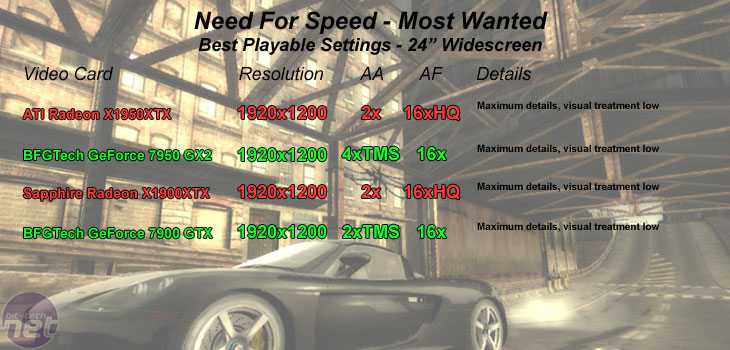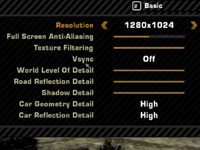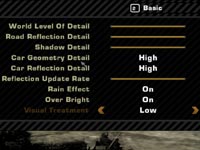For gameplay evaluations on a CRT, please head back to our CRT performance section.
We used the full retail version of Need For Speed: Most Wanted patched to version 1.3. It's the latest addition to Electronic Arts' popular Need For Speed franchise. The game makes use of shaders everywhere, with realistic car reflections, a dynamic sky making use of HDR bloom and also weather patterns that change during the game. Most of the game takes place in the daytime, so aliasing is much more noticeable than it was in previous versions of the Need For Speed: Underground sub-franchise - anti-aliasing is preferred over a higher resolution in order to combat the edge aliasing.
There is a new setting called Visual Treatment which - when set to high - leaves a bright glow on most objects that get in the way of the sunlight. We feel this looks slightly unrealistic as the effect is over-used to an extent and it's best left set to the low setting with overbright enabled. Along with this, there's also the fact that the high setting causes a big performance drop, giving yet another argument for leaving it on the lower setting.
We did a manual run through of the Hwy 2001 sprint track that lasts for around 4 minutes. This is sufficient time to experience the rain effect and normal weather conditions in the same run through. The track gives a good idea of what NFS: Most Wanted will perform like on any card, as it goes around most regions in the NFS world.

 The Radeon X1950XTX delivered a reasonable gaming experience in NFS: Most Wanted, but it wasn't comparable to the experience delivered by the GeForce 7900 GTX and moreso the GeForce 7950 GX2. NFS: Most Wanted was dominated by the GeForce 7950 GX2 at 1920x1200. We were able to turn transparency multisampling AA on for both NVIDIA video cards, with the GeForce 7950 GX2 being capable of smooth game play with 4x AA.
The Radeon X1950XTX delivered a reasonable gaming experience in NFS: Most Wanted, but it wasn't comparable to the experience delivered by the GeForce 7900 GTX and moreso the GeForce 7950 GX2. NFS: Most Wanted was dominated by the GeForce 7950 GX2 at 1920x1200. We were able to turn transparency multisampling AA on for both NVIDIA video cards, with the GeForce 7950 GX2 being capable of smooth game play with 4x AA.
We saw very small differences in performance between the Radeon X1950XTX and Radeon X1900XTX - it was worth around 4 frames per second in favour of the newer part. The lack of any performance-orientated transparent texture anti-aliasing when 2x AA is applied was a bit of a weakness for the Radeon X1950XTX, because it is possible that we would have seen some image quality advances.
Need For Speed: Most Wanted:
Publisher: Electronic ArtsWe used the full retail version of Need For Speed: Most Wanted patched to version 1.3. It's the latest addition to Electronic Arts' popular Need For Speed franchise. The game makes use of shaders everywhere, with realistic car reflections, a dynamic sky making use of HDR bloom and also weather patterns that change during the game. Most of the game takes place in the daytime, so aliasing is much more noticeable than it was in previous versions of the Need For Speed: Underground sub-franchise - anti-aliasing is preferred over a higher resolution in order to combat the edge aliasing.
There is a new setting called Visual Treatment which - when set to high - leaves a bright glow on most objects that get in the way of the sunlight. We feel this looks slightly unrealistic as the effect is over-used to an extent and it's best left set to the low setting with overbright enabled. Along with this, there's also the fact that the high setting causes a big performance drop, giving yet another argument for leaving it on the lower setting.
We did a manual run through of the Hwy 2001 sprint track that lasts for around 4 minutes. This is sufficient time to experience the rain effect and normal weather conditions in the same run through. The track gives a good idea of what NFS: Most Wanted will perform like on any card, as it goes around most regions in the NFS world.


We saw very small differences in performance between the Radeon X1950XTX and Radeon X1900XTX - it was worth around 4 frames per second in favour of the newer part. The lack of any performance-orientated transparent texture anti-aliasing when 2x AA is applied was a bit of a weakness for the Radeon X1950XTX, because it is possible that we would have seen some image quality advances.

MSI MPG Velox 100R Chassis Review
October 14 2021 | 15:04











Want to comment? Please log in.